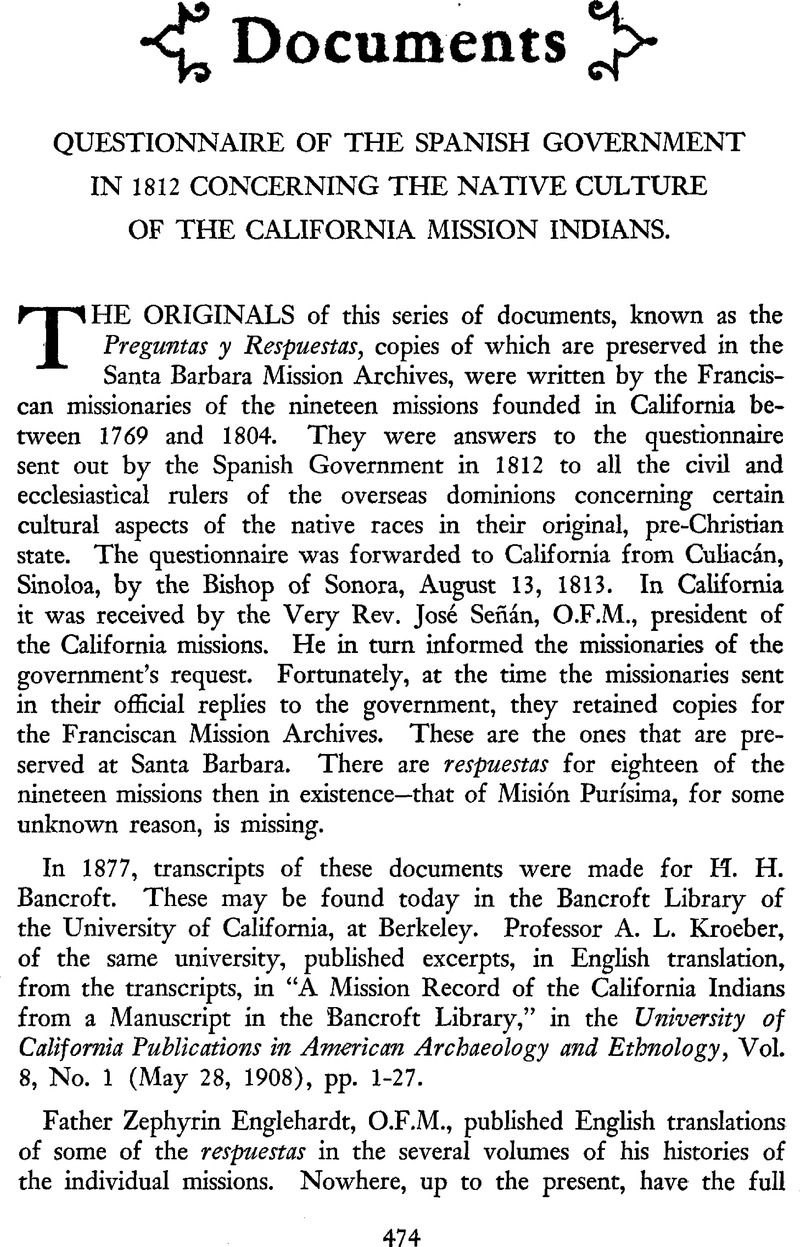Published online by Cambridge University Press: 11 December 2015

1 The Bishop of Sonora between 1797 and 1813 was Fray Francisco Rouset, O.F.M.
2 Señán was president of the California missions the first time between Dec. 8, 1812, and Nov. 22, 1815.
3 Kroeber, op. cit., p. 4, has Man instead of Mau but in footnote 3 states the reading should probably be Mau. Kroeber depended on the translation made by others who in turn were dependent on a transcript made in 1877 from the original in the Santa Barbara Mission Archives. (Hereinafter SBMA). The SBMA document has Mau excluding the possibility of any other reading.
4 Engelhardt, Mission San Diego, 179, has Saa. The Berkeley transcript has Faa, for this is the form Kroeber uses. The letter in the Santa Barbara manuscript is heavily inked and is written over another letter. Engelhardt took it for a long, initial s which Sánchez sometimes employs. However initially Sánchez had written a capital F, part of which can be seen and over this in heavier ink he wrote a small f to make it conform with the small m in mau.
5 The question was: “On the supposition that there are contributing causes to this last named item, what remedies could be applied in order to win over and reconcile the natives?”
6 Kroeber, op. cit., 4, in his text translates gavilán as “vulture.” In note 4, p. 4, he writes that the bird “is more probably the eagle than the California condor, which the word gavilán properly indicates.” Informed Spaniards as well as standard dictionaries point out that gavilán means sparrow-hawk.
7 The question was: “Do you still notice among them any tendency toward idolatry? Explain the nature of the idolatry and unfold the means that can be employed to uproot it.”
8 This last sentence is missing in Engelhardt, op. cit., 181.
9 Engelhardt, op. cit., 181, has Quisiyag. The original document has Quisiyay.
10 Within four lines the writer of the original document spells the name two different ways: Quisiyay and Cusiyay. The lettering is clear and unmistakable.
11 There are slight variations with regard to numbers given in this document and the annual report written by the same authors for the year 1814. This present document was signed on Dec. 23, while the annual report was made out on Dec. 31. The annual report states there were 77 baptisms during the year, 15 of which were baptisms of whites; the report gives the number of Indian deaths at 116, 94 of whom were adults and 22 children. Original annual report, Mission San Diego, 1814, SBMA.
12 The annual report above cited states that the number of cattle belonging to Mission San Diego at the end of the year 1814, was 3,560; sheep, 9,924. According to the biennial report for 1813–1814 there was a total of 1,428 Indians belonging to the mission at the end of 1814. SBMA.
13 The question was: “In their pagan state, in many places, they adored the sun and the moon. You are to state if they still have any memory of this or any tendency toward it.”
14 The question was: “Do you notice if they retain any inclination to immolate human victims to their gods in cases of idolatry into which they fall and of which there are any examples?”
15 Most of this paragraph is wanting in Engelhardt, op. cit., 184–185.